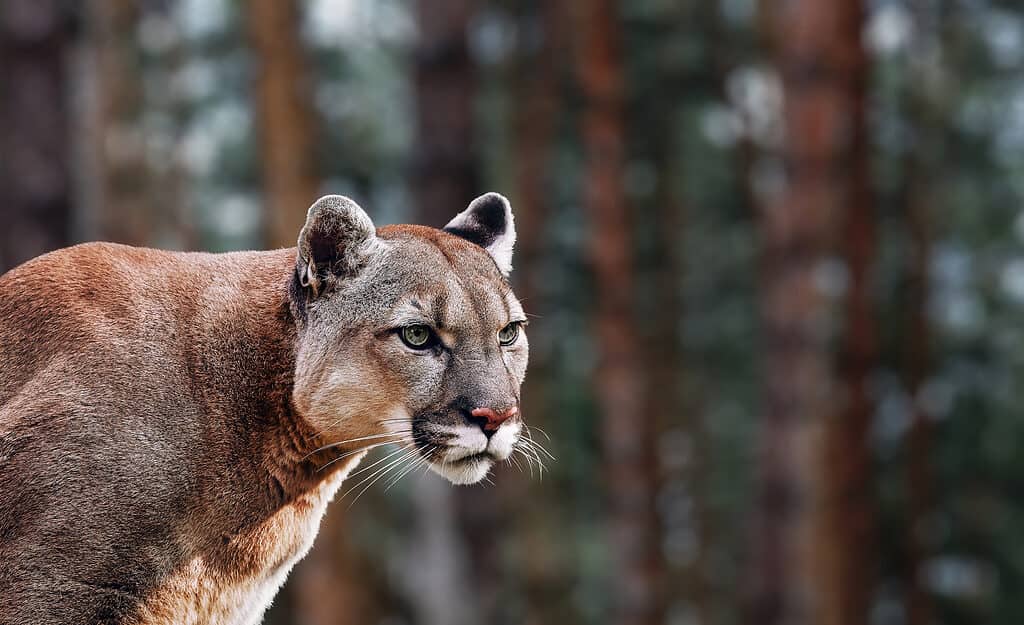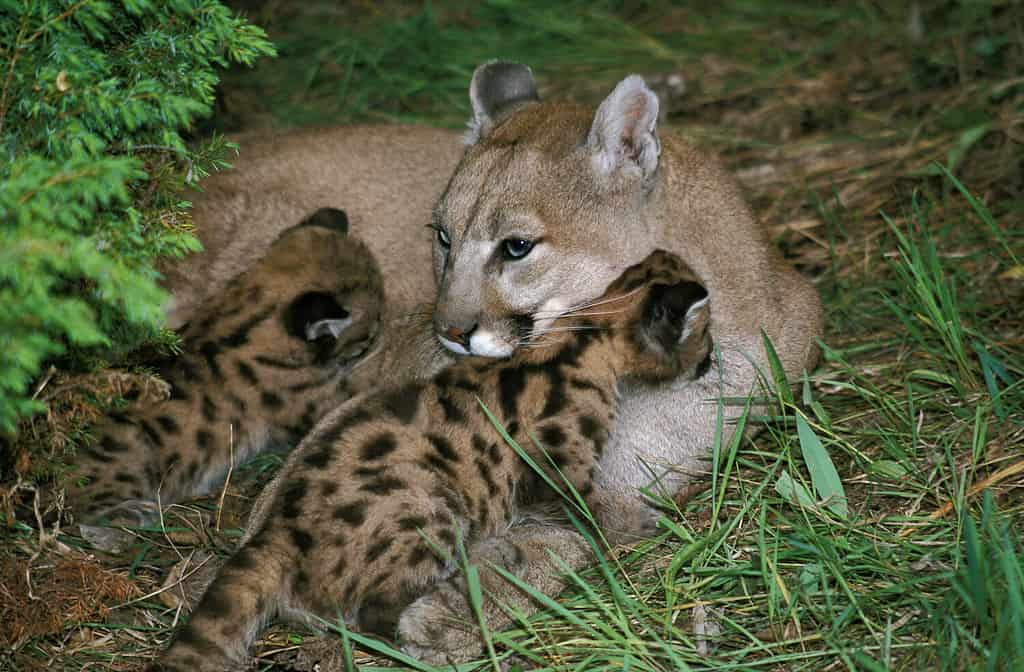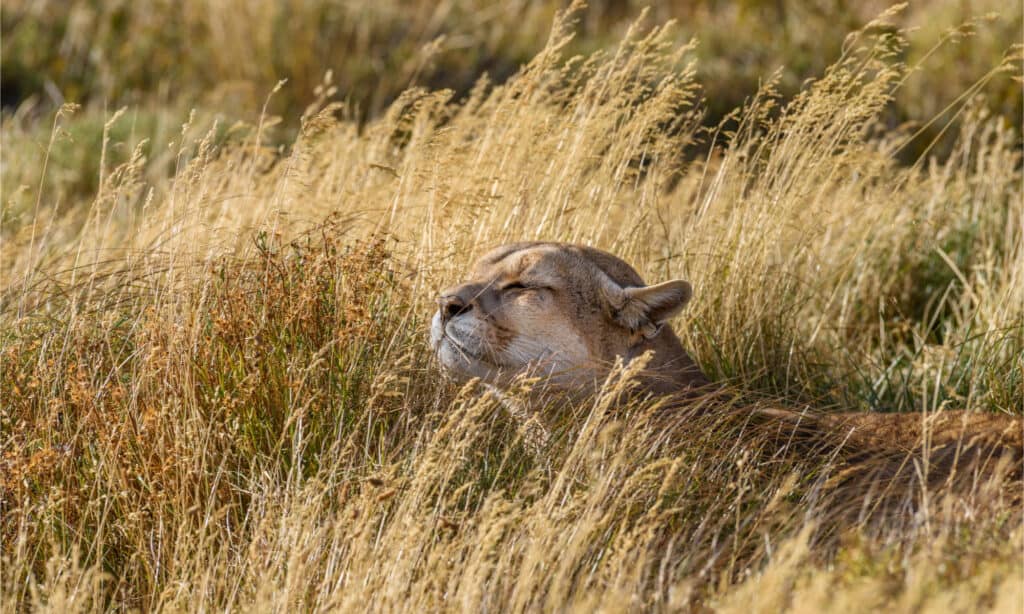Mountain lions are so strong they belong in the same big cat category as cheetahs, tigers, and jaguars! Seeing one in the wild can be a thrilling experience. But what starts as a moment of wonder can quickly turn into a deadly scenario if you’re dealing with a predatory cat. Would you know how to survive a mountain lion encounter?
Mountain lions don’t usually attack people. But attacks do happen. If you’re heading into big cat territory, prepare by reading this short guide. We’ll explain the best tips for preventing an attack and handling an encounter safely.
Mountain Lion Identification

Mountain lions live in nearly every environment.
©Evgeniyqw/Shutterstock.com
Knowing how to identify a mountain lion in the wild can help keep you safe. Fully grown mountain lions have a white underbelly. Their top coat is usually light brown, almost cinnamon, and they have black coloration on the tip of their tail and ears.
The scientific name for mountain lion is Puma con-color, translating to mean “cat of one color.” Worldwide these cats have many names, including cougar, red tiger, and puma.
Identify Mountain Lion Tracks
Mountain lion tracks are big. Since they have retractable claws, they don’t usually show in the tracks. And the front tracks are usually wider than the back ones.
You can also identify mountain lion tracks by studying the palm pad. The large track usually has an m-shape. There will be two lobes at the front of the track and three toward the back.
How Dangerous Are Mountain Lions?

A mountain Lion Close-Up.
©Kwadrat/Shutterstock.com
Mountain lions are dangerous to deer but not so much to people. Encounters between these wild cats and people are rare, and attacks are also rare. You’re more likely to be struck by lightning than attacked by a mountain lion. That being said, mountain lions are insanely strong predators who commonly kill prey twice their size.
A single bite from a mountain lion and its lights out! They also have sharp claws that can slash their prey, delivering a deadly blow with one swipe.
Where Do Mountain Lions Live?
There are 15 states nationwide that have mountain lions. What are the chances you’ll have a mountain lion encounter? The answer depends on which state you live in.
Colorado has the most mountain lions, with population numbers around 7,000 high. The dense forests provide plenty of hunting grounds here, and the big cats love it.
California is also home to a healthy mountain lion population. There are an estimated 4,000 to 6,000 mountain lions throughout California.
Texas has mountain lions, but not nearly as many as California or Colorado. The exact numbers are unknown, but most of the big cats stick to the far western TransPecos region of the state.
Are you hiking in South Dakota? Then odds are you won’t see any mountain lions. There are an estimated 200 to 300 mountain lions thanks to reintroduction efforts.
Mountain Lion Hot Spots
If deer are present, mountain lions are likely nearby. These big cats prefer mountainous terrain. However, they’re comfortable navigating steep rocky canyons too.
Living throughout deserts and coastal forests, an adult mountain lion’s home range can extend past 100 square miles. Females usually have a range of 20 to 60 square miles.
Tips for Living Safely Around Mountain Lions

An adult mountain lion’s home range can extend past 100 square miles.
©Chris Alcock/Shutterstock.com
Do you live in a state with mountain lions? Then you can do your part to avoid a mountain lion encounter from happening in the first place.
For starters, whenever you’re outside, make some noise. If you ever see a wild mountain lion, resist the urge to feed them. Don’t leave food out or encourage them to return. This includes feeding wildlife that could attract mountain lions. If you’re feeding turkey and elk, you might accidentally attract the big cats that prey on them.
Next, trim the landscaping around your house. Get rid of any low-lying vegetation where mountain lions might hide. Removing dense vegetation is especially important around children’s play areas.
Whenever kids are playing outside, keep a close eye on them. Dusk and dawn are the most likely times for a mountain lion attack, so be extra vigilant during these hours. If you have domestic animals, keep them indoors.
Always walk your pets on a leash to discourage mountain lions and predators. When feeding your pets, do so indoors. If you feed them outside, you could attract hungry mountain lions!
It’s also a good idea to install outdoor lighting. Keep walkways easy to see, so you can always spot an approaching lion. Consider motion sensor tools that can scare off a mountain lion too. For instance, motion sensor lights, sprinklers, or inflatable scarecrows can do the trick.
More Ways to Prevent a Mountain Lion Attack
How can you prevent a mountain lion attack on the trail? Check with local park authorities before you hit the trail. Find out if there have been any repeated mountain lion sightings. And always be open guard throughout your hike.
Always make your presence known when you go hiking. Wear bear bells, sing, talk loudly, or use noise makers. You can buy a whistle or a horn to avoid a surprise encounter with wildlife.
If you can travel with a group, do so. Predatory animals are less likely to attack a group when compared to an individual. Plus, if you get hurt in some other way, like a trip and fall, you’ll have friends there to get help.
If you come across mountain lion kittens, get far away from them. The mother is nearby and won’t be happy to see you.
When choosing a campsite, avoid setting up near rock overhangs and cliffs. You should also avoid animal trails and thick brush.
If you can leave pets at home, do so. Taking pets out with you can attract mountain lions. While these big cats might not target humans, they’re notorious for going after domestic animals.
Keep your eyes open for signs of mountain lion activity along the trail. Look for claw marks or scat. Piles of grass or pine needles can point toward lion activity too. Mountain lions create scratch piles with pine needles, leaves, grass, and dirt.
If you see a dead animal, get away quickly. Animal carcasses attract big cats, and you don’t want to be around during feeding time.
Finally, don’t let any children lag or run ahead. Make sure you talk to kids about mountain lions and teach them what to do if an encounter happens.
How to Handle a Mountain Lion Encounter
When you see a mountain lion in the wild, give it space! Never approach a wild animal. Most wildlife, mountain lions included, will try to avoid human encounters. Provide the lion with an escape route, and wait it out.
Never run from a mountain lion. These big cats are agile and fast. They’re used to chasing down deer, so chasing down a person isn’t challenging. Running can trigger the mountain lion’s chase instinct. Instead, stand your ground.
Make direct eye contact with the lion, and don’t break it. And always face forward. Don’t turn your back on the mountain lion at any point. Similar to surviving a wolf encounter, mountain lions are a predator you have to face head-on. Retreat to the inside of a vehicle or building if possible.
Speak loudly in a monotone voice. Don’t scream wildly at the big cat; screaming sounds could sound like some of their prey. Instead, be firm with your voice and be loud. Continue to face the mountain lion and avoid bending over.
Standing up, you can appear to be a threat. But bending down or crouching over can make you appear like vulnerable prey. If you’re picking up small children, do so without making yourself smaller, and move slowly. Always move slowly around a wild cat.
Make Yourself Appear Big and Intimidating
Make yourself big to scare the mountain lion away. Slowly wave your arms, open your jacket, and puff yourself up. Keep your movements slow and confident. You don’t want to appear erratic but rather firm and composed. Keep speaking calmly and loudly, and don’t stop.
Throw Things
If making yourself look big and loud doesn’t intimidate the mountain lion, you’ll need to throw things at it. Don’t throw anything directly at the cat; this could trigger an attack. Instead, throw things towards it to scare it away, like warning shots.
Remember to avoid bending or crouching when you’re getting things to grab. Grab branches, sticks, stones, and anything within reach. Be slow, and keep your eyes focused on the mountain lion.
Use Your Backpack
Is there anything in your backpack you can throw? Use it! Your flashlight can be the perfect warning shot. Aim for the brush right by the big cat, and see if the noise of the flashlight landing scares them away. Water bottles are another good projectile to grab while keeping yourself upright.
Don’t throw everything, though! As a last resort, you may need to swing your backpack at the wild cat. You’ll want some weight in your pack so it swings out and scares the mountain lion away.
Read the Mountain Lions Body Language
Knowing how to read an animal’s body language makes it easy to know what to do next. When you see a mountain lion in the wild, pay attention to its actions. Is the big cat aware of you but not paying attention? Be cautious and avoid rapid movements. Don’t talk excitedly, and stay close to your group. Change direction and get out of the area while moving slowly.
Does the cat have its ears up? Are they attentive to your presence? If the mountain lion is 50 yards away or closer, you have a potentially dangerous situation. Never turn your back on the cat and hold small children. Keep larger children behind adults and get to a safe location. If you have a firearm, have it ready. If not, look for any weapon nearby and keep it on hand. Just avoid crouching down to pick anything up.
Is the mountain lion less than 50 yards away? Are the ears back and eyes fixed? Then an attack is likely. Get ready to use anything nearby as a weapon. Maintain eye contact, and stay as calm as possible. Let’s say the mountain lion has its ears back and keeps approaching you. Now would be the time to use a firearm if you have a firearm. This animal sees you as prey right now. Don’t play dead. If you play dead, a predatory mountain lion is sure to attack. Instead, you’ll need to defend yourself and show the big cat that you’re not an easy meal!
How to Defend Yourself Against a Mountain Lion

Knowing how to read an animal’s body language makes it easy to know what to do next.
©Evgeniyqw/Shutterstock.com
The mountain lion’s powerful bite, large claws, and swift movements make it an unfair match for any person. However, there are stories of people successfully fighting off mountain lions. Once you show a mountain lion, you’re not going to back down; chances are you’ll scare it off.
How Mountain Lions Attack
Mountain lions are ambush predators. These stealthy predators will silently stalk prey before pouncing from behind. After tackling their prey, mountain lions usually deliver a deadly bite to the spinal cord. They also go for the prey’s throat.
If a mountain lion attacks, fight back with everything you have. But make sure you protect yourself as much as possible in the process. Do everything you can to protect your throat and head.
How Common Are Mountain Lion Attacks?
Fatal mountain lion attacks are incredibly rare. They occur less often than fatal bee stings or lightning strikes. Over the last 100 years, there have been 126 mountain lion attacks in North America, with 27 being fatal. Usually, attacks happen on children since they’re easier targets for hungry animals.
Mountain Lion Attacks in California
Mountain lion attacks are rare, but they do happen. Since 1986, there have been 22 confirmed mountain lion attacks throughout California. Thankfully, the majority of the attacks were non-fatal. Take, for instance, the mountain lion who went after a child in Pico Canyon Park, California. The young boy was climbing steps when the big cat bit him from behind. The injuries were severe enough for the boy to need hospitalization. The encounter might have been deadly if the father hadn’t scared the big cat away so quickly.
An example of a fatal encounter occurred on January 31, 1909, in Balboa, California. A mountain lion attacked and killed a child sleeping in their tent.
Young Mountain Lion Attacks Colorado Man and Loses
Young mountain lions aren’t as skilled at hunting as their elders. Sometimes they go after the wrong type of prey, which was the case when a young mountain lion went after a Colorado man. The man was unarmed and had only his feet and hands to defend himself, along with a few rocks.
After going for a run in the afternoon, the 31-year-old went down a wooded section of the trail. Suddenly a mountain lion was barreling down the path toward him. The man tried scaring the big cat away, but it continued to pursue.
After lunging on him, the Colorado man had to fight back with all his might. Grabbing for a rock, he began hitting the mountain lion over the head. The mountain lion kept fighting, but eventually, the man won the battle by suffocating the cat.
How to Survive a Mountain Lion Attack
Now you know the best course of action during a mountain lion encounter and attack. Make yourself big and loud. Throw sticks, rocks, or objects toward the big cat, but not directly at it. Always face the threat, and never turn your back on a mountain lion.
Maintain steady eye contact, and keep your voice loud but monotone. Chances are, you’ll scare the mountain lion away in seconds. But if not, prepare your weapon, and get ready to fight.
Attacks from mountain lions on humans are rare. But now you’ll know what to do if you’re ever in this unfortunate situation! Check out the articles below for more ways to stay safe while enjoying the outdoors.
Are Mountain Lions Endangered or Threatened Species?

Keystone species, like mountain lions, must be protected for a healthy ecosystem to thrive.
©slowmotiongli/Shutterstock.com
Mountain Lions, also known as cougars and pumas, are found throughout the western United States. Their less common names are panthers and catamounts. They can range from Canada to Patagonia in South America. In the U.S., mountain lions are listed as a species of least concern by the International Union for Conservation of Nature (IUCN).
However, Mountain Lion populations have declined significantly due to habitat loss and fragmentation caused by human activities such as urban development and agriculture.
Though there are still some stable mountain lion populations in certain wild areas, we must not be complacent when it comes to their conservation. In areas near human development, such as state parks, their numbers are rapidly declining and could eventually lead to local extinction, especially in populated areas like the Bay Area, California. If this occurs, it could have disastrous effects not just on the lions but on other species, including humans. To ensure that balance is maintained and restored, it is important to have a healthy mountain lion population throughout the country. This is especially true in places where humans and mountain lions exist together.
How Are Mountain Lions Beneficial?

Because mountain lions eat deer, they help keep the population from growing too large.
©Danita Delimont/Shutterstock.com
Mountain lions are classified as keystone and bellwether species, meaning that they have a significant role in the ecosystem and should be maintained at a steady population size.
Humans are an integral part of the environment and without a diverse range of plants and animals, we would be unable to take advantage of the various benefits that nature has to offer. Mountain lions are important for human survival because they help control the deer population. By hunting weakened deer, they keep the population healthy and balanced. This makes them a keystone species in the ecosystem.
The presence of mountain lions helps to regulate the deer population, which in turn benefits agriculture. When the mountain lions are gone, the deer population becomes overpopulated and causes economic issues, car accidents, tick-borne diseases, and the destruction of native plants. To address these issues, there is an effort to reintroduce mountain lions in regions where they are extinct. By doing this, we will be able to create a stronger, healthier environment for both mountain lions and humans.
The photo featured at the top of this post is © Geoffrey Kuchera/Shutterstock.com
Thank you for reading! Have some feedback for us? Contact the AZ Animals editorial team.






